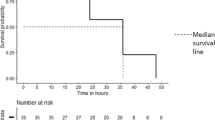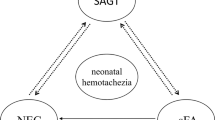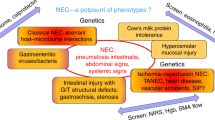Abstract
Objective:
We hypothesized that neonates with bloody stools and concomitant eosinophilia are likely to have atopic enteropathy rather than necrotizing enterocolitis (NEC).
Study Design:
This was a retrospective cross-sectional study using electronic medical records and paper charts. Records of neonates admitted to any Intermountain Healthcare NICU between 1 January 2005 and 30 June 2010 were eligible if ‘bloody stools’ were listed in any archive. Qualifying records were divided into two groups depending on whether or not within 72 h of passing bloody stool eosinophil counts were above the 95th percentile reference range limit for age.
Result:
Bloody stools were identified in 275 predominantly Caucasian neonates. Fifty-four of these had eosinophilia and 221 had normal eosinophil counts. Those with eosinophilia were born at a slightly younger gestational age (31.3±4.6 vs 32.6±4.0 weeks, mean±s.d., P=0.032). Contrary to our hypothesis, those with eosinophilia did not have a lower rate of pneumatosis or bowel resection, or death ascribed to NEC. Eosinophilia was more common among those who had a red blood cell (RBC) transfusion within 48 h before passing bloody stools (P<0.001). Those with a recent RBC transfusion were the only neonates to have NEC surgery or to die from NEC. Preceding the bloody stools, those with no antecedent transfusion had been fed a larger volume (P=0.014), and had trends toward receiving calorically enriched feedings (P=0.055) and recent addition of human milk fortifier (P=0.060). Eosinophil counts following RBC transfusion tended to increase for 3–6 days, but when bloody stools were not preceded by transfusion the eosinophil counts were more static over that period.
Conclusion:
In this predominantly Caucasian group of neonates with bloody stools, the presence of eosinophilia did not identify a benign condition distinct from NEC. A total of 44% of these neonates had transfusion-associated NEC. Eosinophils could have a previously unrecognized role in the pathogenesis of this NEC subtype.
This is a preview of subscription content, access via your institution
Access options
Subscribe to this journal
Receive 12 print issues and online access
$259.00 per year
only $21.58 per issue
Buy this article
- Purchase on Springer Link
- Instant access to full article PDF
Prices may be subject to local taxes which are calculated during checkout


Similar content being viewed by others
References
Moqbel R, Odemuyiwa SO, Lacy P, Adamko DJ . The human eosinophil. Lippincott/Williams & Wilkins pubs: Philadelphia, 2009, pp 214–235.
Christensen RD, Jensen J, Maheshwari A, Henry E . Reference ranges for blood concentration of eosinophils and monocytes during the neonatal period defined from over 63,000 records in a multihospital health-care system. J Perinatol 2010; 30: 540–545.
Christensen RD, Gordon PV, Besner GE . Can we cut the incidence of necrotizing enterocolitis in half-today? Fetal Pediatri Path 2010; 29: 185–198.
Baer VL, Lambert DK, Schmutz N, Henry E, Stoddard RA, Miner C et al. Adherence to NICU transfusion guidelines: data from a multihospital healthcare system. J Perinatol 2008; 28: 492–497.
Baer VL, Henry E, Lambert DK, Stoddard RA, Wiedmeier SE, Eggert LD et al. Implementing a program to improve compliance with neonatal intensive care unit transfusion guidelines was accompanied by a reduction in transfusion rate: a pre-post analysis within a multihospital health care system. Transfusion 2011; 51: 264–269.
Bell MJ, Shackelford P, Feigin RD, Ternberg JL, Brotherton T . Epidemiologic and bacteriologic evaluation of neonatal necrotizing enterocolitis. J Pediat Surg 1997; 14: 1–4.
Walsh MC, Kliegman RM . Necrotizing enterocolitis: treatment based on staging criteria. Pediatr Clin North Am 1986; 33: 179–202.
Vermont Oxford Network Database. Manual of Operations, Release 10.0, 2007, pp 77, 78.
Gordon PV, Clark R . In response to the case report of allergic enterocolitis in a preterm neonate: how prevalent is systemic eosinophilia with NEC? J Perinatol 2011; 31: 297–298.
Srinivasan P, Brandler M . Response to Drs Gordon and Clark. J Perinatol 2011; 31: 298–299.
Srinivasan P, Brandler M, D’Souza A, Millman P, Moreau H . Allergic enterocolitis presenting as recurrent necrotizing enterocolitis in preterm neonates. J Perinatol 2010; 30: 431–433.
Hirose R, Yamada T, Hayashida Y . Massive bloody stools in two neonates caused by cow's milk allergy. Pediatr Surg Int 2006; 22: 935–938.
Lake AM . Food-induced eosinophilic proctocolitis. J Pediatr Gastroenterol Nutr 2000; 30 (Suppl): S58–S60.
Ohtsuka Y, Shimizu T, Shoji H, Kudo T, Fujii T et al. Neonatal transient eosinophilic colitis causes lower gastrointestinal bleeding in early infancy. J Pediatr Gastroenterol Nutr 2007; 44: 501–505.
Clark RH, Gordon PV, Walker WM, Laughon M, Smith PB, Spitzer AR . Characteristics of patients who die of necrotizing enterocolitis. J Perinatol; doi:10.1038/jp2011.65, e-pub ahead of print 19 May 2011.
Gordon PV, Swanson JR, Attridge JT, Clark R . Emerging trends in acquired neonatal intestinal disease: is it time to abandon Bell's criteria? J Perinatol 2007; 27: 661–671.
Maloney J, Nowak-Wegrzyn A . Educational clinical case series for pediatric allergy and immunology: allergic proctocolitis, food protein-induced enterocolitis syndrome and allergic eosinophilic gastroenteritis with protein-losing gastroenteropathy as manifestations of non-IgE-mediated cow's milk allergy. Pediatr Allergy Immunol 2007; 18: 360–367.
Juul SE, Haynes JW, McPherson RJ . Evaluation of eosinophilia in hospitalized preterm infants. J Perinatol 2005; 25: 182–188.
Bhat AM, Scanlon JW . The pattern of eosinophilia in newborn infants. Acta Paediatr 1994; 83: 612–615.
Christensen RD, Lambert DK, Henry E, Wiedmeier SE, Snow GL, Baer VL et al. Is ‘transfusion-associated necrotizing enterocolitis’ an authentic pathogenic entity? Transfusion 2010; 50: 1106–1112.
Josephson CD, Wesolowski A, Bao G, Sola-Visner MC, Dudell G, Castillejo MI et al. Do red cell transfusions increase the risk of necrotizing enterocolitis in premature infants? J Pediatr 2010; 157: 972–978. e1-3.
Blau J, Calo JM, Dozor D, Sutton M, Alpan G, La Gamma EF . Transfusion-related acute gut injury: necrotizing enterocolitis in very low birth weight neonates after packed red blood cell transfusion. J Pediatr 2011; 158: 403–409.
El-Dib M, Narang S, Lee E, Massaro AN, Aly H . Red blood cell transfusion, feeding and necrotizing enterocolitis in preterm infants. J Perinatol 2011; 31: 183–187.
Singh R, Visintainer PF, Frantz III ID, Shah BL, Meyer KM, Favila SA et al. Association of necrotizing enterocolitis with anemia and packed red blood cell transfusions in preterm infants. J Perinatol 2011; 31: 176–182.
Paul DA, Mackley A, Novitsky A, Zhao Y, Brooks A, Locke RG . Increased odds of necrotizing enterocolitis after transfusion of red blood cells in premature infants. Pediatrics 2011; 127: 635–641.
Ghirardello S, Lonati CA, Dusi E, Pugni L, Mosca F . Necrotizing enterocolitis and red blood cell transfusion. J Pediatr 2011; 159 (2): 354–355.
Yen JM, Lin CH, Yang MM, Hou ST, Lin AH, Lin YJ . Eosinophilia in very low birth weight neonates. Pediatr Neonatol 2010; 51: 116–123.
Manoura A, Hatzidaki E, Korakaki E, Valari V, Giannakopoulou C . Eosinophilia in sick neonates. Haematologia 2002; 32: 31–73.
Christensen RD . Association between red blood cell transfusion and necrotizing enterocolitis. J Pediatr 2011; 158: 349–350.
Gordon PV . What progress looks like in NEC research. J Perinatol 2011; 31: 149.
Author information
Authors and Affiliations
Corresponding author
Ethics declarations
Competing interests
The authors declare no conflict of interest.
Additional information
Supplementary Information accompanies the paper on the Journal of Perinatology website
Supplementary information
Rights and permissions
About this article
Cite this article
Christensen, R., Lambert, D., Gordon, P. et al. Neonates presenting with bloody stools and eosinophilia can progress to two different types of necrotizing enterocolitis. J Perinatol 32, 874–879 (2012). https://doi.org/10.1038/jp.2011.163
Received:
Accepted:
Published:
Issue Date:
DOI: https://doi.org/10.1038/jp.2011.163
Keywords
This article is cited by
-
A murine neonatal model of necrotizing enterocolitis caused by anemia and red blood cell transfusions
Nature Communications (2019)
-
Calprotectin and necrotizing enterocolitis: it’s not the assay, it’s the definition
Journal of Perinatology (2018)
-
Reference intervals for stool calprotectin in preterm neonates and their utility for the diagnosis of necrotizing enterocolitis
Journal of Perinatology (2018)
-
Increased monocytes and bands following a red blood cell transfusion
Journal of Perinatology (2016)
-
The complete blood cell count in a refined cohort of preterm NEC: the importance of gestational age and day of diagnosis when using the CBC to estimate mortality
Journal of Perinatology (2016)



